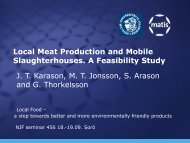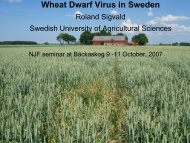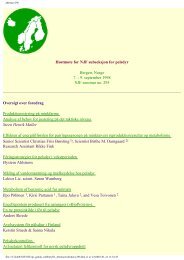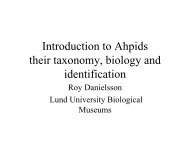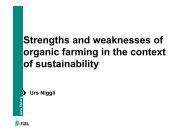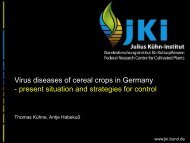measurement methods of soil, water, plant and fruit, in berry ... - NJF
measurement methods of soil, water, plant and fruit, in berry ... - NJF
measurement methods of soil, water, plant and fruit, in berry ... - NJF
Create successful ePaper yourself
Turn your PDF publications into a flip-book with our unique Google optimized e-Paper software.
PROTOCOL FOR SCREENING OF PECTINS IN FRUITS OF<br />
JAPANESE QUINCE (CHAENOMELES JAPONICA)<br />
Kimmo Rumpunen<br />
Balsgård - Department <strong>of</strong> Horticultural Plant Breed<strong>in</strong>g, Swedish University <strong>of</strong><br />
Agricultural Sciences, Fjälkestadsvägen 123-1, 291 94 Kristianstad, Sweden.<br />
Tel.: +46-44-75533; fax: +46-44-75530.<br />
E-mail address: kimmo.rumpunen@hvf.slu.se (K. Rumpunen)<br />
Abstract<br />
An important component <strong>of</strong> <strong>fruit</strong> dietary fibre is pect<strong>in</strong>s, which have well documented health<br />
benefits <strong>and</strong> <strong>in</strong>dustrial applications. Estimat<strong>in</strong>g content <strong>of</strong> pect<strong>in</strong>s <strong>in</strong> <strong>plant</strong> material is,<br />
however, difficult because <strong>of</strong> their complex composition <strong>and</strong> because <strong>of</strong> their association with<br />
other cell wall materials. In this paper a comb<strong>in</strong>ed enzymatic <strong>and</strong> HPLC method is presented,<br />
that recently was validated for analysis <strong>of</strong> galacturonic acid (GalA) <strong>in</strong> alcohol-<strong>in</strong>soluble solids<br />
(AIS), <strong>and</strong> <strong>in</strong> pect<strong>in</strong>s, extracted from <strong>fruit</strong>s <strong>of</strong> Japanese qu<strong>in</strong>ce (Chaenomeles japonica). The<br />
enzymatic/HPLC method proved to be useful as a simple <strong>and</strong> efficient screen<strong>in</strong>g method s<strong>in</strong>ce<br />
a very high correlation was obta<strong>in</strong> between GalA estimates <strong>of</strong> the <strong>fruit</strong> <strong>and</strong> the AIS content <strong>of</strong><br />
acid extracted pect<strong>in</strong>s <strong>in</strong> Japanese qu<strong>in</strong>ce.<br />
Keywords: Alcohol-<strong>in</strong>soluble solids; Galacturonic acid; Pect<strong>in</strong>s; Screen<strong>in</strong>g method; Uronic<br />
acids<br />
Introduction<br />
Pect<strong>in</strong>s are widely used <strong>in</strong> various foods as gell<strong>in</strong>g or thicken<strong>in</strong>g agents, <strong>and</strong> are at present<br />
commercially extracted by hot dilute acid, ma<strong>in</strong>ly from citrus <strong>fruit</strong>s. Pect<strong>in</strong>s are considered as<br />
valuable components <strong>of</strong> dietary fibres s<strong>in</strong>ce they are able to reduce blood plasma cholesterol<br />
levels <strong>and</strong> provide other health benefits to humans (Sungsoo Cho <strong>and</strong> Dreher 2001). Fresh<br />
<strong>fruit</strong>s are a valuable source <strong>of</strong> pect<strong>in</strong>s. The content <strong>of</strong> pect<strong>in</strong>s <strong>in</strong> <strong>fruit</strong>s is therefore important,<br />
<strong>and</strong> should be considered also <strong>in</strong> <strong>plant</strong> breed<strong>in</strong>g.<br />
In breed<strong>in</strong>g, efficient screen<strong>in</strong>g <strong>methods</strong> are needed to enable analysis <strong>of</strong> large number <strong>of</strong><br />
genotypes. Quantitative extraction <strong>of</strong> pect<strong>in</strong>s <strong>in</strong> <strong>plant</strong> material is, however, difficult because<br />
<strong>of</strong> their complicated chemical nature <strong>and</strong> because <strong>of</strong> their association with other cell wall<br />
materials. The extraction method as such affects the yield <strong>and</strong> composition <strong>of</strong> pect<strong>in</strong>s <strong>and</strong><br />
therefore also presents problems <strong>and</strong> may <strong>in</strong>duce artefacts. In those pect<strong>in</strong>s, which are<br />
composed ma<strong>in</strong>ly <strong>of</strong> GalA polymers, e.g. apple pect<strong>in</strong>s (Voragen et al. 1995), analysis <strong>of</strong> the<br />
GalA monomers may be a method to estimate the total amount <strong>of</strong> pect<strong>in</strong>s present <strong>in</strong> the<br />
sample. Furthermore, the content <strong>of</strong> GalA appears to be more stable dur<strong>in</strong>g <strong>fruit</strong> ripen<strong>in</strong>g than<br />
the content <strong>of</strong> extractable pect<strong>in</strong>s (e.g. <strong>in</strong> apple, Fischer <strong>and</strong> Amadò 1994). GalA is usually<br />
analysed colorimetrically after acid hydrolysis (Thibault 1979). The colorimetric method can<br />
only be used for analysis <strong>of</strong> purified samples, which make it less efficient as a screen<strong>in</strong>g<br />
method <strong>in</strong> <strong>plant</strong> breed<strong>in</strong>g, <strong>and</strong> therefore enzymatic <strong>methods</strong> have been advocated.<br />
In this paper a comb<strong>in</strong>ed enzymatic <strong>and</strong> HPLC method is described. The method has<br />
recently been validated for analysis <strong>of</strong> galacturonic acid (GalA) <strong>in</strong> alcohol-<strong>in</strong>soluble<br />
solids (AIS), <strong>and</strong> <strong>in</strong> pect<strong>in</strong>s, extracted from <strong>fruit</strong>s <strong>of</strong> Japanese qu<strong>in</strong>ce (Chaenomeles<br />
japonica) <strong>and</strong> for screen<strong>in</strong>g <strong>of</strong> pect<strong>in</strong>s (Rumpunen et al. 2002). Japanese qu<strong>in</strong>ce is<br />
presently studied <strong>and</strong> developed as a commercial crop <strong>in</strong> a jo<strong>in</strong>t north-European <strong>plant</strong><br />
breed<strong>in</strong>g program. Japanese qu<strong>in</strong>ce is a dwarf shrub belong<strong>in</strong>g to Maloideae



